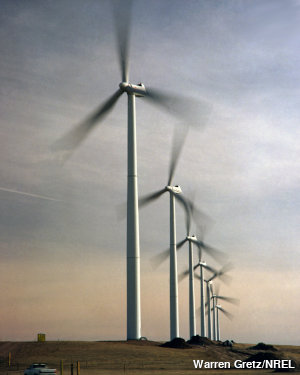 Wind turbines are like airplanes running on the spot—spinning round but going nowhere. They're serving a very useful purpose, however. There's energy locked in wind and these giant propellers can capture some of it and turn it instantly into electricity. Have you ever stopped to wonder how wind turbines work? Let's take a closer look!
Wind turbines are like airplanes running on the spot—spinning round but going nowhere. They're serving a very useful purpose, however. There's energy locked in wind and these giant propellers can capture some of it and turn it instantly into electricity. Have you ever stopped to wonder how wind turbines work? Let's take a closer look!
Photo: Left: A small wind farm in Colorado, United States. These are relatively small turbines: each one produces about 700kW of energy (enough to supply 225 homes). The turbines are 79m (260ft) high (from the ground to the very top of the rotors) and the rotors themselves are 48.5m (159ft) in diameter. The top part of each turbine (called the nacelle) rotates on the tower beneath so the spinning blades are always facing directly into the wind. Photo by Warren Gretz courtesy of US Department of Energy/NREL (DoE/NREL).
How does a turbine generate electricity?
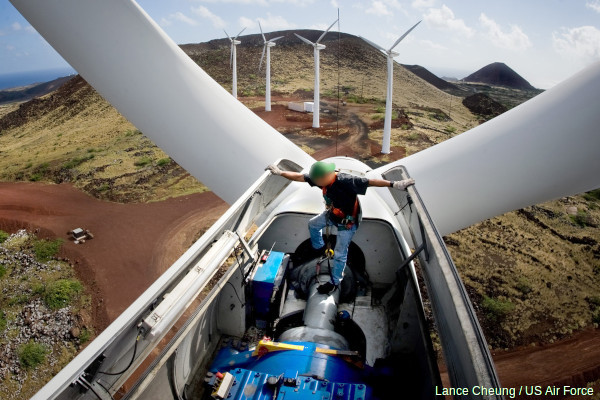
A turbine is a machine that spins around in a moving fluid (liquid or gas) and catches some of the energy passing by. All sorts of machines use turbines, from jet engines to hydroelectric power plants and from diesel railroad locomotives to windmills. Even a child's toy windmill is a simple form of turbine.
The huge rotor blades (propellers) on the front of a wind turbine are the "turbine" part. As wind passes by, the kinetic energy (energy of movement) it contains makes the blades spin around (usually quite slowly). The blades have a special curved shape so they capture as much energy from the wind as possible.
Although we talk about "wind turbines," the turbine is only one of the three main parts inside these giant machines. The second part is a gearbox whose gears convert the slow speed of the spinning blades into higher-speed rotary motion—turning the drive shaft quickly enough to power the electricity generator.
The generator is the third main part of a turbine and it's exactly like an enormous, scaled-up version of the dynamo on a bicycle. When you ride a bicycle, the dynamo touching the back wheel spins around and generates enough electricity to make a lamp light up. The same thing happens in a wind turbine, only the "dynamo" generator is driven by the turbine's rotor blades instead of by a bicycle wheel, and the "lamp" is a light in someone's home dozens of miles away. Read more in our main article about generators.
Photo: Head for heights! You can see just how big a wind turbine is compared to this engineer, who's standing right inside the nacelle (main unit) carrying out maintenance. Notice how the white blades at the front connect via an axle (gray—under the engineer's feet) to the gearbox and generator behind (blue). Photo by Lance Cheung courtesy of US Air Force.
How does a wind turbine work?

- Wind (moving air that contains kinetic energy) blows toward the turbine's rotor blades.
- The rotors spin around slowly, capturing some of the kinetic energy from the wind, and turning the central drive shaft that supports them.
- The rotor blades can swivel on the hub at the front so they meet the wind at the best angle for harvesting energy.
- Inside the nacelle (the main body of the turbine sitting on top of the tower and behind the blades), the gearbox converts the low-speed rotation of the drive shaft (about 16 revolutions per minute, rpm) into high-speed (1600 rpm) rotation fast enough to drive the generator efficiently.
- The generator, immediately behind the gearbox, takes kinetic energy from the spinning drive shaft and turns it into electrical energy.
- Anemometers (wind-speed monitors) and wind vanes on the back of the nacelle provide measurements about the wind speed and direction.
- Using these measurements, the entire top part of the turbine (the rotors and nacelle) can be rotated by a yaw motor, mounted between the nacelle and the tower, so it faces directly into the oncoming wind and captures the maximum amount of energy. If the wind speed rises too much, brakes are applied to stop the rotors from turning (for safety reasons).
- The electric current produced by the generator flows through a cable running down through the inside of the turbine tower.
- A substation transforms the voltage of the electricity so it can be transmitted efficiently to nearby communities.
- Homes enjoy clean, green energy.
- Wind carries on blowing past the turbine, but with lower speed and lower energy (for reasons explained below) and more turbulence (since the turbine has disrupted its flow).
How turbines harvest maximum energy
If you've ever seen a wind turbine, you'll know that they are absolutely gigantic and mounted on incredibly high towers. The bigger the rotor blades, the more energy they can capture from the wind. The giant blades (typically 70 m or 230 feet in diameter, which is about 30 times the wingspan of an eagle) multiply the wind's force like a wheel and axle, so even a gentle breeze is enough to make the outer edges of the blades turn around. Although the blades rotate quite slowly, the inner axle and turbine rotate with greater force—enough to turn the generator and make electricity. (Wind turbines usually have anemometers—automatic speed measuring devices—built into them and brakes that lock the blades if the wind speed is too high.)

A typical wind turbines is 85 meters (280 feet) off the ground—that's like 50 tall adults standing on one another's shoulders! There's a good reason for this. If you've ever stood on a hill that's the tallest point for miles around, you'll know that wind travels much faster when it's clear of the buildings, trees, hills, and other obstructions at ground level. So if you put a turbine's rotor blades high in the air, they capture considerably more wind energy than they would lower down. And capturing energy is what wind turbines are all about.
Photo: This unusual Darrieus "egg-beater" wind turbine rotates about a vertical axis, unlike a normal propeller turbine. Its main advantage is that it can be mounted nearer to the ground, without a tower, which makes it cheaper and simpler to construct. Photo by courtesy of US Department of Energy.
Since the blades of a wind turbine are rotating, they must have kinetic energy, which they "steal" from the wind. Now it's a basic law of physics (known as theconservation of energy) that you can't make energy out of nothing, so the wind must actually slow down slightly when it passes around a wind turbine. That's not really a problem, because there's usually plenty more wind following on behind! It is a problem if you want to build a wind farm: unless you're in a really windy place, you have to make sure each turbine is a good distance from the ones around it so it's not affected by them.
Advantages and disadvantages of wind turbines
One of the drawbacks of wind turbines is that they don't generate anything like as much energy as a conventional power plant. Each turbine makes about 1 megawatt of power, which is enough to power 500 electric toasters running simultaneously—and enough to supply about 1000 homes. You'd need about 1000–2000 turbines to make as much power as a really sizable coal-fired power plantor a nuclear power station (either of which can generate enough power to run a million toasters at the same time). But on the plus side, wind turbines are clean and green: unlike coal stations, they don't make the carbon dioxide emissions that are causing global warming or the sulfur dioxide emissions that cause acid rain. And they don't have the security and pollution problems many people associate with nuclear power. Is wind the energy of the future? It just might be!
But what if the wind doesn't blow?
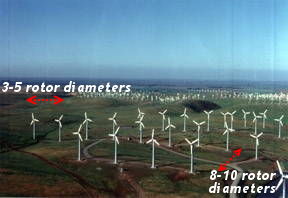
It's hard to imagine why anyone would object to clean and green wind turbines—especially when you compare them to dirty coal-fired plants and risky nuclear ones. Some people worry that because wind is very variable, we might suddenly lose all our electricity and find ourselves plunged into a "blackout" (a major power outage) if we rely on it too much.
The reality of wind is quite different. Wherever you live, your power comes from a complex grid (network) of highly interconnected power-generating units (ranging from giant power plants to individual wind turbines). Utility companies are highly adept at balancing power generated in many different places, in many different ways, to match the load (the total power demand) as it varies from hour to hour and day to day. The power from any one wind turbine will fluctuate as the wind rises and falls, but the total power produced by thousands of turbines, widely dispersed across an entire country, is much more regular and predictable. For a country like the UK, it's pretty much always windy somewhere. As Graham Sinden of Oxford University's Environmental Change Institute has shown, low wind speeds affect more than half the country for only 10 percent of the time; for 60 percent of the time, only 20 percent of the UK suffers from low wind speeds; and only for one hour per year is 90 percent of the UK suffering low speeds (Sinden 2007, figure 7). In other words, having many wind turbines spread across many different places guarantees a reasonably steady supply of wind energy virtually all year round.
While it's true that you might need 1000 wind turbines to produce as much power as a giant coal or nuclear plant, it's also true that if a single wind turbine fails or stops turning, it causes only 1/1000th (0.1 percent) of the disruption you get when a coal or nuclear plant fails (which happens more often than you might think). It's also worth bearing in mind that wind is extremely predictable several days in advance so it's easy for power planners to take account of its variability as they figure out how to make enough power to meet expected demands.
Opponents of wind power have even suggested that it might be counter-productive, because we'd still need to have backup coal or nuclear plants (or some way of storing wind-generated electricity) for those times when there's not enough wind blowing. That would certainly be true if we made all our energy from one, single mega-sized wind turbine—but we don't! In reality, even countries that have large supplies of wind energy have plenty of other sources of power too (Denmark, for example, makes 20 percent of its electricity—and meets 43 percent of its peak load—with wind); as long as wind power is making less than half of a country's total energy, the variability of the wind is not a problem.
Photo: You can put lots of turbines together to make a wind farm, but you need to space them out to harvest the energy effectively. Combining the output from many wind farms in many different areas produces a smoother and more predictable power supply. This wind farm is at one of the world's windiest places: Altamont Pass, California, United States. Photo by courtesy of US Department of Energy.
Micro-wind turbines
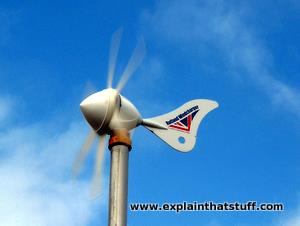
If small is beautiful, micro-wind turbines—tiny power generators perched on a roof or mast—should be the most attractive form of renewable energy by far. Some manufacturers have pushed the technology aggressively, hinting to consumers about big savings on electricity bills and major benefits for the environment. The reality is a little different: micro-turbines do indeed bring economic and environmental benefits if they're sited in reliably windy areas, but they're less helpful in towns and cities where buildings make "energy harvesting" more of a challenge. So are micro-wind turbines really worth the investment? How do they compare with their big brothers?
Photo: Micro power to the people! This small, mast-mounted Rutland Windcharger is designed to trickle-charge 12V and 24V batteries, such as those used in small boats, far from the grid. At a wind speed of 40–55 km/h (20–30 knots), it will produce a handsome 140–240 watts of power. At 20 km/h (10 knots), it produces a rather more modest 27 watts.
How micro-wind turbines compare
These figures are simply designed to give a rough comparison of the differences between large-scale and micro-wind turbines. Bear in mind that there's a huge variety of micro-turbines.
- Mounting:
- Conventional: Mounted on a tower roughly 80–100m (260–344ft) high.
- Micro: Mounted on roof or on a small, freestanding mast typically ~10m (30ft) high.
- Rotor diameter:
- Conventional: Up to 90m (300ft).
- Micro: ~1–4m (40 inches to 12ft).
- Energy production:
- Conventional: 1–2 megawatts (1000–2000 kilowatts).
- Micro: 400–40,000 watts (0.4–40 kilowatts).
- Operates in wind speeds:
- Conventional: ~10–55mph (16–90 km/h).
- Micro: ~10–40 mph (16–64 km/h).
- Cost:
- Conventional: ~$2 million.
- Micro: $500–30,000 (typically under $10,000).
- Provides power to:
- Conventional: 500–1500 homes.
- Micro: 1 home.
How to set up your own micro-wind turbine
If you want to build your own micro-wind turbine, what do you need? Apart from the turbine itself, you also typically need a piece of electrical equipment called aninverter (which converts the direct-current electricity produced by the turbine's generator into alternating current you can use in your home) and appropriate electrical cabling. Your turbine will also need either a connection into the grid supply or batteries to store the energy it produces.
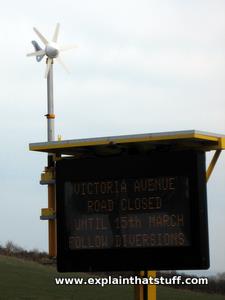
Aside from the equipment, here are a few pointers worth bearing in mind:
- The best place to start is with a professional assessment of your site's wind potential, which involves a series of measurements with an anemometer. Remember that wind turbines generally work far better in open, rural areas than mounted on rooftops in cities.
- Don't assume it will automatically be windy enough to make the investment in a microturbine worthwhile: a recent UK study of microturbines by Encraft found a mixed picture, with good performance from the best-located turbines and the very worst performing model (embarrassingly) not even producing enough electricity to power its own electronics—in other words, using more electricity overall than it produced. Some contribution to the environment!
- Depending on where you live, you will almost certainly need planning consent for a wind turbine, so check that out carefully with your local authority first.
- Sound out your neighbors before you start spending any money: instead of turning your "local friends" into bitter enemies with your rooftop propeller, maybe you could persuade them to join you in a community green-energy venture?
- Remember that roof-mounted wind turbines could prove noisy and cause problems with vibration.
- Don't forget that there are all kinds of other energy technologies that might give a quicker and better return on your investment and make more difference to the planet. Energy efficiency measures (such as improved heat insulation) generally give the quickest payback for least cost and make the most difference in the short-term, and solar hot water systems work very well almost anywhere. Ground-source heat pumps are also worth a look.
Photo: Although micro-wind turbines on homes have proved controversial, they definitely have their place. Here's the Rutland Windhcharger from our top photo helping to charge the batteries in a go-anywhere, portable highway construction sign. It's getting help from the large flat solar panel mounted on top. This is a great example of how micro-wind turbines can be useful if you put them in the right place, at the right time.
No comments:
Post a Comment